Get Ready to be “CYPRUSED” at a Bank near you
Stock-Markets / Financial Markets 2013 Jun 02, 2013 - 12:42 PM GMT The banking situation in Europe continues to deteriorate rapidly. As a measure of the ongoing crisis the “ Bail In” option used in Cyprus is actually being made European Commission policy. The following is a recent report from the much respected Irish Times:
The banking situation in Europe continues to deteriorate rapidly. As a measure of the ongoing crisis the “ Bail In” option used in Cyprus is actually being made European Commission policy. The following is a recent report from the much respected Irish Times:
“Proposals under Irish presidency to deal with European bank collapses likely to ‘bail-in’ large depositors.
Deposits of over €100,000 are likely to be hit in the event of future European bank collapses, according to a proposal put forward by the Irish presidency of the European Council ahead of a key meeting of finance ministers next week.
Discussions on the controversial bank resolution regime, which is likely to see savers with deposits over €100,000 “bailed in” as part of future bank wind-downs, are due to intensify this week in Brussels, ahead of Tuesday’s meeting, which will be chaired by Minister for Finance, Michael Noonan.
“We will try to get some guidance from Ministers about the possible design of the bailout tool,” one EU official said yesterday.
Under a compromise text proposed by the Irish presidency, uninsured deposits of over €100,000 would be bailed in in the event that a bank is resolved, but depositors would rank higher than other creditors in the event of a wind-down.
In this scenario – known as “deposit preference” – depositors would rank at the very end of the process, with other creditors first absorbing losses.
However, some member states have not ruled out the possibility that insured deposits, i.e. deposits under €100,000, would be forced to bear losses in the event of a bank collapse even though these deposits would be likely to be protected by the deposit guarantee scheme.
However, the explicit exclusion of insured deposits from future “bail-ins” could in fact be included in the final text, according to some sources, with some MEPs in particular keen to include such a provision.
Significant differences still remain between states on the issue, with some countries calling for greater flexibility as regards the application of the new rules on a national basis, including the possibility that individual countries could be permitted to exempt large depositors from losses if a bank fails.
The introduction of an EU-wide bank resolution process, which would govern how banks are wound down, is a key strand of the EU’s plan for a pan-European banking union, which was endorsed by EU leaders at last June’s summit.
However, the chaotic Cyprus bailout instilled the issue with greater urgency, with EU lawmakers now keen to provide clarity around bank collapses.
This year Jeroen Dijsselbloem, head of the group of 17 euro zone finance ministers, said that losses on bondholders and depositors could form part of future bank bailouts as euro zone officials seek to move the burden of bailouts away from taxpayers – as was the case in the Irish bailout – and on to private investors.
The European Commission argues that this switch from so-called “bailouts” to “bail-ins” would result in an allocation of losses that would not be worse than the losses that shareholders and creditors would have suffered in regular insolvency proceedings that apply to other private companies.
While the new rules governing bank resolution were first intended to come into place in 2018, since the Cypriot bailout there have been calls from senior EU figures such as European Central Bank president Mario Draghi and EU economics affairs commissioner Olli Rehn to introduce the new regime as early as 2015.
The Irish presidency of the European Council is hoping to reach a common position by the end of next month.”
Below is a copy from a Laikie Bank customer’s business account. This was one of the “bad” banks in Cyprus. This puts into clear terms what happened to client’s funds. As they say a picture tells a thousand words. (This image is published courtesy of MarketOracle.Co.UK).
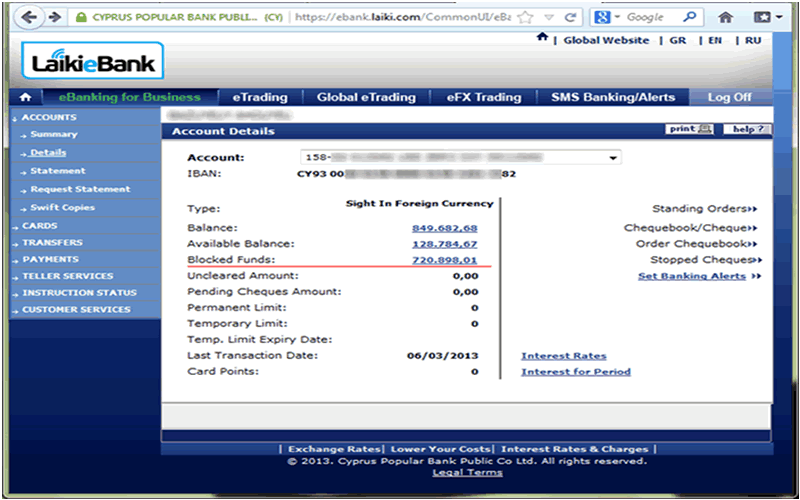
No wonder the European Central Bank has ceased providing accurate information on Euro wide bank liquidity levels. According to sources of mine funds are transferring out of Euroland at an alarming rate. Given what is currently being discussed in Dublin who would blame any corporate entity or individual removing all Euro funds from possible confiscation.
The Best Is Now The Least Worst:
The current boom in American equities is a “strategic boom” not a fundamental one.
The Macro Economic chart below shows that the real economic situation for the American consumer is terrible. Thus in my opinion stocks are being bought up not because fund managers have great expectations for future earnings but because it is the “least worst” option. Governments around the world may be contemplating confiscating large percentages of banked cash balances but many believe that “they” would never sequester your shares in IBM or McDonalds or Microsoft. Ergo cash is no longer “king”.
Chart: Divergence between index of American Macro Economic Indicators and the S & P.
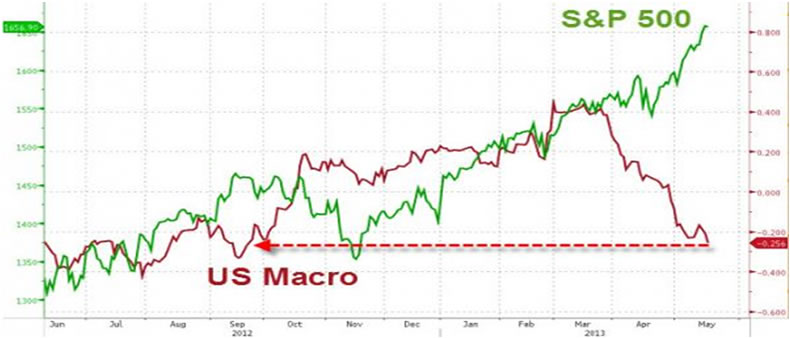
(Chart: Courtesy of Zero Hedge).
With regard the Dow 30, the S&P 500 and particularly the NASDAQ, they were all beginning to show early signs of “parabolic” price action.
Technically, parabolic moves are not good as in most cases uncorrected price rises end in painful over- compensating crashes.
The current pullback was expected as the market was so over-bought it was inevitable that profit taking would come into play at some point.
My view is that this bull has legs and the ideal investment strategy is to accumulate target stocks following solid technical consolidations.
I have been asked whether one should consider shorting now. I would not recommend automatically shorting stock against a bull trend of the magnitude we are currently experiencing as the possibility of being “whiplashed” is very high. However, if the 5900 level on the Trannies is violated there is a strong likelihood that the current choppy market action will turn into a strong bear trend. At that juncture put options on the QQQs will have a very high probability of being an excellent short term trade, particularly if the Hindenberg Omen, signaled on Friday, is re-confirmed.
Dow Transports: Daily
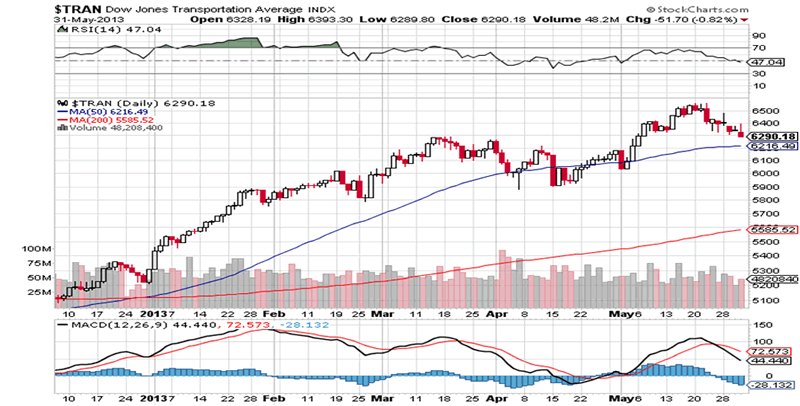
S&P 500: Daily

NASDAQ: Daily
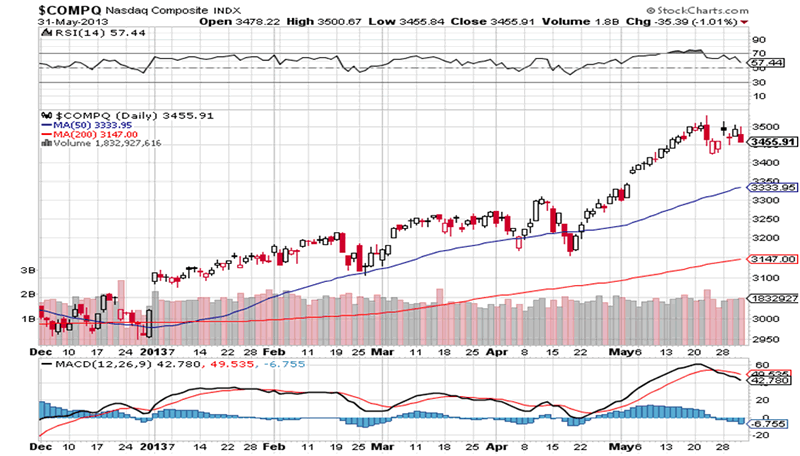
Dow Industrials: Daily
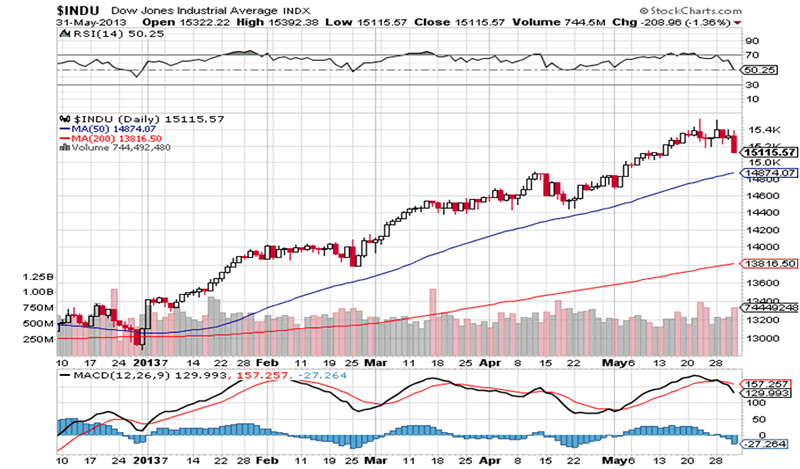
Charts: Courtesy of StockCharts.Com
By Christopher M. Quigley
B.Sc., M.M.I.I. Grad., M.A.
http://www.wealthbuilder.ie
Mr. Quigley was born in 1958 in Dublin, Ireland. He holds a Bachelor Degree in Accounting and Management from Trinity College Dublin and is a graduate of the Marketing Institute of Ireland. He commenced investing in the stock market in 1989 in Belmont, California where he lived for 6 years. He has developed the Wealthbuilder investment and trading course over the last two decades as a result of research, study and experience. This system marries fundamental analysis with technical analysis and focuses on momentum, value and pension strategies.
Since 2007 Mr. Quigley has written over 80 articles which have been published on popular web sites based in California, New York, London and Dublin.
Mr. Quigley is now lives in Dublin, Ireland and Tampa Bay, Florida.
© 2013 Copyright Christopher M. Quigley - All Rights Reserved
Disclaimer: The above is a matter of opinion provided for general information purposes only and is not intended as investment advice. Information and analysis above are derived from sources and utilising methods believed to be reliable, but we cannot accept responsibility for any trading losses you may incur as a result of this analysis. Individuals should consult with their personal financial advisors before engaging in any trading activities.
Christopher M. Quigley Archive |
© 2005-2022 http://www.MarketOracle.co.uk - The Market Oracle is a FREE Daily Financial Markets Analysis & Forecasting online publication.



